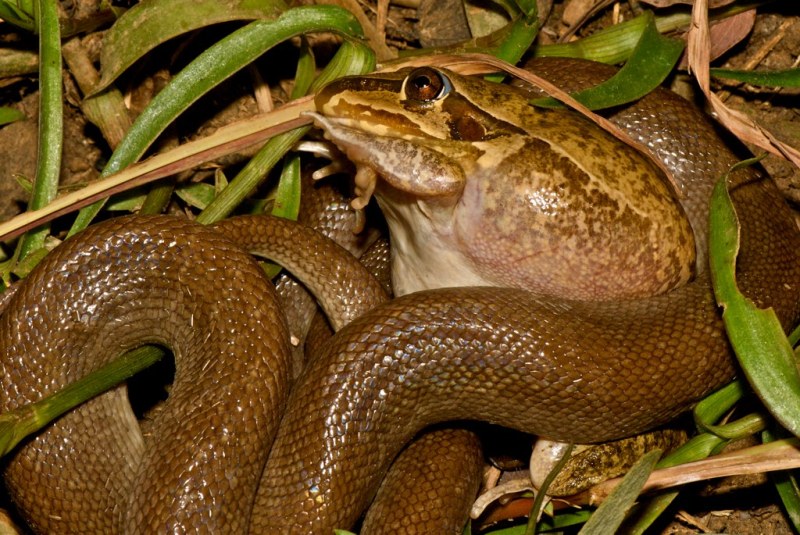
©Pete Hill: Children's Python (Antaresia childreni) constricting a Giant Burrowing Frog (Cyclorana australis)
Colours
Distinguishing features
The crown scales are enlarged while those on the body are small and smooth, with a rainbow sheen that can be seen when exposed to direct sunlight.
Dorsum is brown with darker spots in five or six longitudinal series. A dark streak on each side of the head, passes through the eye. Lips are yellowish, spotted with brown. The ventrum is uniformly yellowish.
Head is distinct from neck. Nostril is superolateral, in a large semidivided nasal. Eye is moderate in size, with vertical pupil. Body is slightly laterally compressed. The tail is short.
Smooth dorsal scales are arranged in 41 to 45 rows; ventrals 257−287; anal plate entire; subcaudals 38−53, all or mostly in two rows.
Rostral is broader than high, barely visible from above. Internasals are slightly longer than broad and are shorter than the anterior prefrontals. Second pair of prefrontals are in contact at midline or separated by a small shield. These posterior prefrontals sometimes broken into several shields. Frontal 1½ times as long as broad, slightly shorter than its distance from the end of the snout, longer than the small parietals. There are 3 to 10 small loreal shields, some almost granular, and 11 to 13 upper labials. Three or four of the posterior lower labials have deep pits.
Anterior maxillary teeth and mandibular teeth are very long, gradually decreasing in size posteriorly. Premaxillary bone also has teeth. (Wikipedia)
Size
- Up to 150 cm (Length of specimen)
Synonyms
Similar taxa
Distribution
Distribution and habitat preferences
It is found in Australia in the extreme north of Western Australia, the northern third of Northern Territory, and northeastern Queensland and also on the islands of the Torres Strait.
It occurs specifically in the region spanning along the coast between the Kimberleys in Western Australia to Mount Isa in northwestern Queensland. (Wikipedia)
Diet
The diet consists of reptiles, birds and small mammals, particularly microbats which they catch by dangling from stalactites in caves, which they commonly inhabit, and snatch them out of the air as they fly past. (Wikipedia)
Web resources
Danger
- mild discomfort - They can bite and have sharp teeth but are non-venomous.


